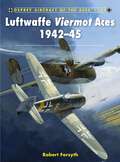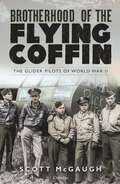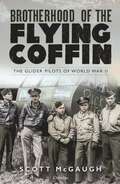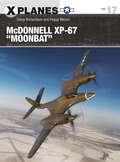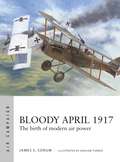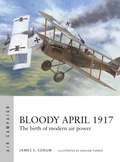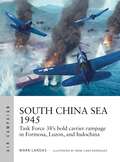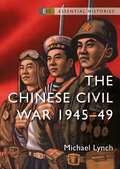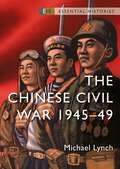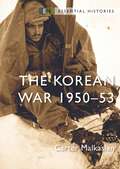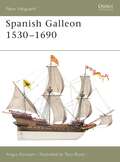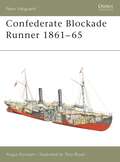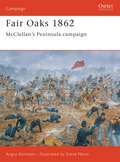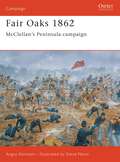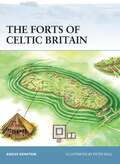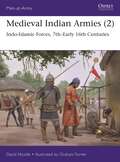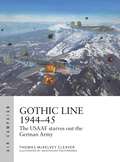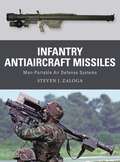- Table View
- List View
Luftwaffe Viermot Aces 1942–45 (Aircraft of the Aces)
by Robert ForsythA full account of the German airmen who achieved ace status by destroying Allied bombers.Viermot Aces' were pilots who shot down five or more USAAF and RAF bombers during the daylight Defence of the Reich missions from May 1942 through to VE Day. This book tells the complete story of the men and the planes that challenged the great bomber offensive. Flying a number of different aircraft including the Bf 110G, Me 210 and the Me 410, they fought their desperate battles against the numerous machine guns of B-17s and Lancasters. This book also covers the 'jet aces' that flew the Me 262 jet-powered interceptors in the closing days of the war to wage a desperate last-ditch fight against the endless Allied bomber fleets.
Brotherhood of the Flying Coffin: The Glider Pilots of World War II
by Scott McGaughThe first major history of the American glider pilots, the forgotten heroes of World War II, by New York Times bestselling author Scott McGaugh. A story of no guns, no engines and no second chances.This book distills war down to individual young men climbing into defenseless gliders made of plywood, ready to trust the towing aircraft that would pull them into enemy territory by a single cable wrapped with a telephone wire. Based on their after-action reports, journals, oral histories, photos and letters home, The Brotherhood of the Flying Coffin reveals every terrifying minute of their missions.They were all volunteers, for a specialized duty that their own government projected would have a 50 percent casualty rate. None faltered. In every major European invasion of the war they led the way. They landed their gliders ahead of the troops who stormed Omaha Beach, and sometimes miles ahead of the paratroopers bound for the far side of the Rhine River in Germany itself. From there, they had to hold their positions. They delivered medical teams, supplies and gasoline to troops surrounded in the Battle of the Bulge, ahead even of Patton's famous supply truck convoy. These all-volunteer glider pilots played a pivotal role in liberating the West from tyranny, from the day the Allies invaded Occupied Europe to the day Germany finally surrendered. Yet the story of these anonymous heroes is virtually unknown. Here their story is told in full – a story which epitomizes courage, dedication and sacrifice.
Brotherhood of the Flying Coffin: The Glider Pilots of World War II
by Scott McGaughThe first major history of the American glider pilots, the forgotten heroes of World War II, by New York Times bestselling author Scott McGaugh. A story of no guns, no engines and no second chances.This book distills war down to individual young men climbing into defenseless gliders made of plywood, ready to trust the towing aircraft that would pull them into enemy territory by a single cable wrapped with a telephone wire. Based on their after-action reports, journals, oral histories, photos and letters home, The Brotherhood of the Flying Coffin reveals every terrifying minute of their missions.They were all volunteers, for a specialized duty that their own government projected would have a 50 percent casualty rate. None faltered. In every major European invasion of the war they led the way. They landed their gliders ahead of the troops who stormed Omaha Beach, and sometimes miles ahead of the paratroopers bound for the far side of the Rhine River in Germany itself. From there, they had to hold their positions. They delivered medical teams, supplies and gasoline to troops surrounded in the Battle of the Bulge, ahead even of Patton's famous supply truck convoy. These all-volunteer glider pilots played a pivotal role in liberating the West from tyranny, from the day the Allies invaded Occupied Europe to the day Germany finally surrendered. Yet the story of these anonymous heroes is virtually unknown. Here their story is told in full – a story which epitomizes courage, dedication and sacrifice.
McDonnell XP-67 "Moonbat" (X-Planes)
by Steve Richardson Peggy MasonPacked with never-before-seen photos, plans and meticulous new digital artwork, this is the first history of the USAAF's futuristic World War II prototype interceptor, the XP-67 "Moonbat".The series of X-planes that sprang from the US Army's Request for Data R40C, focused on high-altitude, high-speed, long-range bomber interceptors. Among these aircraft was the McDonnell Aircraft Company's first ever clean sheet design, the XP67. Its futuristic lines promised performance that it was ultimately unable to deliver, but development was still underway when disaster struck. Just before Army performance demonstration flights were scheduled to begin, an engine fire destroyed the only XP-67 prototype, leaving a host of unanswered questions about what might have been, and leading to decades of continuing fascination with the XP-67 among aviation buffs and aircraft modelers.The authors of this book have uncovered new sources of information and a wealth of photographs and line drawings that document not just the XP-67 but also its immediate precursors within the McDonnell Aircraft design community, as well as alternative configurations for unbuilt variants aimed at different missions. Packed with unpublished photos of all stages of construction including key airframe changes made after initial flight tests, showing in detail how the final configuration was evolved, this volume finally provides clear focus on a story that has long been shrouded in mystery.
McDonnell XP-67 "Moonbat" (X-Planes)
by Steve Richardson Peggy MasonPacked with never-before-seen photos, plans and meticulous new digital artwork, this is the first history of the USAAF's futuristic World War II prototype interceptor, the XP-67 "Moonbat".The series of X-planes that sprang from the US Army's Request for Data R40C, focused on high-altitude, high-speed, long-range bomber interceptors. Among these aircraft was the McDonnell Aircraft Company's first ever clean sheet design, the XP67. Its futuristic lines promised performance that it was ultimately unable to deliver, but development was still underway when disaster struck. Just before Army performance demonstration flights were scheduled to begin, an engine fire destroyed the only XP-67 prototype, leaving a host of unanswered questions about what might have been, and leading to decades of continuing fascination with the XP-67 among aviation buffs and aircraft modelers.The authors of this book have uncovered new sources of information and a wealth of photographs and line drawings that document not just the XP-67 but also its immediate precursors within the McDonnell Aircraft design community, as well as alternative configurations for unbuilt variants aimed at different missions. Packed with unpublished photos of all stages of construction including key airframe changes made after initial flight tests, showing in detail how the final configuration was evolved, this volume finally provides clear focus on a story that has long been shrouded in mystery.
Bloody April 1917: The birth of modern air power (Air Campaign)
by James S. CorumResearched from original-language primary sources, this is a uniquely well-informed and multi-faceted history of the World War I air campaign of Bloody April.Researched from original German-, French-, and English-language sources, and written by an authority on both air and ground military operations, author, Dr James S Corum examines how Bloody April caused Allied forces to reassess their approach to the use of airpower. Considering well-known problems such as technology and training doctrine, but also how the artillery-aircraft combination ideally had to work in late-WW I ground offensives, Dr Corum analyses what each side got wrong and why. He describes little-known parts of the April campaigns, such as both sides' use of strategic bombing with heavy aircraft, and considers the German use of advanced high-altitude reconnaissance aircraft with oxygen and heated suits while detailing the exploits of the infamous 'Red Baron', Manfred von Richthofen.Lessons from Bloody April not only served to improve the coordination of Allied artillery and aircraft but subsequently aircraft played a much larger role in supporting ground troops in attack mode. Bloody April paved the way for the airpower revolution that, by 1918, would make the Allies masters of the sky on the Western Front.
Bloody April 1917: The birth of modern air power (Air Campaign)
by James S. CorumResearched from original-language primary sources, this is a uniquely well-informed and multi-faceted history of the World War I air campaign of Bloody April.Researched from original German-, French-, and English-language sources, and written by an authority on both air and ground military operations, author, Dr James S Corum examines how Bloody April caused Allied forces to reassess their approach to the use of airpower. Considering well-known problems such as technology and training doctrine, but also how the artillery-aircraft combination ideally had to work in late-WW I ground offensives, Dr Corum analyses what each side got wrong and why. He describes little-known parts of the April campaigns, such as both sides' use of strategic bombing with heavy aircraft, and considers the German use of advanced high-altitude reconnaissance aircraft with oxygen and heated suits while detailing the exploits of the infamous 'Red Baron', Manfred von Richthofen.Lessons from Bloody April not only served to improve the coordination of Allied artillery and aircraft but subsequently aircraft played a much larger role in supporting ground troops in attack mode. Bloody April paved the way for the airpower revolution that, by 1918, would make the Allies masters of the sky on the Western Front.
South China Sea 1945: Task Force 38's bold carrier rampage in Formosa, Luzon, and Indochina (Air Campaign)
by Mark LardasA history of the US Navy's remarkable 1945 South China Sea raid against the Japanese, the first time in history that a carrier fleet dared to rampage through coastal waters.As 1945 opened, Japan was fighting defensively everywhere. As the Allies drew closer to the Home Islands, risks of Japanese air and sea attack on the US Navy carrier force increased. US forces wanted to take the island of Luzon which provided a base for Japanese aircraft from Formosa (Taiwan) and Indochina, and from where attacks could easily be devastating for the invasion fleet. US Naval Intelligence also believed Japanese battleships Ise and Hyuga were operating out of Cam Ranh Bay. A fast carrier sweep through the South China Sea was a potential answer with the bonus that it would strike the main nautical highway for cargo from Japan's conquests in Southeast Asia.Task Force 38 would spend the better part of two weeks marauding through the South China Sea during Operation Gratitude, a month-long sweep of the area, which launched air strikes into harbors in Indochina, the Chinese coast and Formosa, while targeting shipping in the high-traffic nautical highway. By the time the Task Force exited the South China Sea, over 300,000 tons of enemy shipping and dozens of Japanese warships had been sunk. With follow-up air strikes against Japanese harbors and airfields in Formosa and the Ryukyu Islands, the success of the sweep was unprecedented.Using detailed battlescenes, maps, bird's eye views, and diagrams of air strikes at Luzon, this intriguing account of Task Force 38's reign in the South China Sea proved that aircraft carriers could dominate the land-based air power of the fading Japanese. From the Korean War through to Vietnam, to the campaigns in Iraq, aircraft carriers could sail safely offshore, knowing their aircraft would prevail on both sea and land.
South China Sea 1945: Task Force 38's bold carrier rampage in Formosa, Luzon, and Indochina (Air Campaign)
by Mark LardasA history of the US Navy's remarkable 1945 South China Sea raid against the Japanese, the first time in history that a carrier fleet dared to rampage through coastal waters.As 1945 opened, Japan was fighting defensively everywhere. As the Allies drew closer to the Home Islands, risks of Japanese air and sea attack on the US Navy carrier force increased. US forces wanted to take the island of Luzon which provided a base for Japanese aircraft from Formosa (Taiwan) and Indochina, and from where attacks could easily be devastating for the invasion fleet. US Naval Intelligence also believed Japanese battleships Ise and Hyuga were operating out of Cam Ranh Bay. A fast carrier sweep through the South China Sea was a potential answer with the bonus that it would strike the main nautical highway for cargo from Japan's conquests in Southeast Asia.Task Force 38 would spend the better part of two weeks marauding through the South China Sea during Operation Gratitude, a month-long sweep of the area, which launched air strikes into harbors in Indochina, the Chinese coast and Formosa, while targeting shipping in the high-traffic nautical highway. By the time the Task Force exited the South China Sea, over 300,000 tons of enemy shipping and dozens of Japanese warships had been sunk. With follow-up air strikes against Japanese harbors and airfields in Formosa and the Ryukyu Islands, the success of the sweep was unprecedented.Using detailed battlescenes, maps, bird's eye views, and diagrams of air strikes at Luzon, this intriguing account of Task Force 38's reign in the South China Sea proved that aircraft carriers could dominate the land-based air power of the fading Japanese. From the Korean War through to Vietnam, to the campaigns in Iraq, aircraft carriers could sail safely offshore, knowing their aircraft would prevail on both sea and land.
The Chinese Civil War: 1945–49 (Essential Histories)
by Michael LynchIn this fully illustrated introduction, Dr Michael Lynch provides a concise overview of the Chinese Civil War, a defining conflict in world history.Between the end of World War II and the dawn of the Cold War, one of the most important conflicts in modern history reached its climax. In this illustrated history, bestselling historian Dr Michael Lynch examines how the long struggle between Chiang Kai-shek's Nationalists and Mao Zedong's Communists exploded into an intense, brutal and ruthlessly fought civil war. Delving into the political background and complex ramifications of the conflict, he assesses Mao and Chiang's millions-strong armies, their strategies and commanders, and the critical campaigns that won and lost China. By 1949 the Nationalist government was defeated and in exile in Taiwan, and the new People's Republic of China was ready to emerge as a major Cold War power.Updated and revised for the new edition, with full-colour maps and new images throughout, this is a concise study of one of the bloodiest conflicts of the 20th century and its significant repercussions, the issues around which remain unresolved today.
The Chinese Civil War: 1945–49 (Essential Histories)
by Michael LynchIn this fully illustrated introduction, Dr Michael Lynch provides a concise overview of the Chinese Civil War, a defining conflict in world history.Between the end of World War II and the dawn of the Cold War, one of the most important conflicts in modern history reached its climax. In this illustrated history, bestselling historian Dr Michael Lynch examines how the long struggle between Chiang Kai-shek's Nationalists and Mao Zedong's Communists exploded into an intense, brutal and ruthlessly fought civil war. Delving into the political background and complex ramifications of the conflict, he assesses Mao and Chiang's millions-strong armies, their strategies and commanders, and the critical campaigns that won and lost China. By 1949 the Nationalist government was defeated and in exile in Taiwan, and the new People's Republic of China was ready to emerge as a major Cold War power.Updated and revised for the new edition, with full-colour maps and new images throughout, this is a concise study of one of the bloodiest conflicts of the 20th century and its significant repercussions, the issues around which remain unresolved today.
The Korean War: 1950–53 (Essential Histories #8)
by Carter MalkasianIn this fully illustrated introduction, Dr Carter Malkasian provides a concise overview of the so-called "Forgotten War" in Korea.From 1950 to 1953, the most powerful countries in the world engaged in a major conventional war in Korea. Yet ironically this conflict has come to be known as the USA's "Forgotten War." Esteemed historian Dr Carter Malkasian explains how this conflict in a small peninsula in East Asia had a tremendous impact on the entire international system and the balance of power between the two superpowers, America and Russia. In this illustrated history, he examines how the West demonstrated its resolve to thwart Communist aggression and the armed forces of China, the Soviet Union and the United States came into direct combat for the only time during the Cold War. Updated and revised for the new edition, with specially commissioned color maps and new images throughout, this is a detailed introduction to a significant turning point in the Cold War.
The Korean War: 1950–53 (Essential Histories)
by Carter MalkasianIn this fully illustrated introduction, Dr Carter Malkasian provides a concise overview of the so-called "Forgotten War" in Korea.From 1950 to 1953, the most powerful countries in the world engaged in a major conventional war in Korea. Yet ironically this conflict has come to be known as the USA's "Forgotten War." Esteemed historian Dr Carter Malkasian explains how this conflict in a small peninsula in East Asia had a tremendous impact on the entire international system and the balance of power between the two superpowers, America and Russia. In this illustrated history, he examines how the West demonstrated its resolve to thwart Communist aggression and the armed forces of China, the Soviet Union and the United States came into direct combat for the only time during the Cold War. Updated and revised for the new edition, with specially commissioned color maps and new images throughout, this is a detailed introduction to a significant turning point in the Cold War.
Spanish Galleon 1530–1690 (New Vanguard)
by Angus KonstamDuring the middle decade of the 16th century a new type of sailing vessel emerged, designed to carry the wealth of the Americas to Spain. This was the galleon, and over the next century these vessels would serve Spain well as treasure ships and warships, becoming a symbol of Spanish power and wealth during the period. The development and construction of the Spanish galleon are discussed in this book, and the ordnance and crewing needed to produce and maintain these stately vessels is covered. The author also examines the role of the galleon as a treasure ship, and describes how these ships were manned and fought in action.
Confederate Blockade Runner 1861–65 (New Vanguard)
by Angus KonstamThe lifeblood of the Confederacy, the blockade runners of the Civil War usually began life as regular fast steam-powered merchant ships. They were adapted for the high-speed dashes through the Union blockade which closed off all the major Southern ports, and for much of the war they brought much-needed food, clothing and weaponry to the Confederacy. This book traces their operational history, including the development of purpose-built blockade running ships, and examines their engines, crews and tactics. It describes their wartime exploits, demonstrating their operational and mechanical performance, whilst examining what life was like on these vessels through accounts of conditions on board when they sailed into action.
Confederate Blockade Runner 1861–65 (New Vanguard)
by Angus KonstamThe lifeblood of the Confederacy, the blockade runners of the Civil War usually began life as regular fast steam-powered merchant ships. They were adapted for the high-speed dashes through the Union blockade which closed off all the major Southern ports, and for much of the war they brought much-needed food, clothing and weaponry to the Confederacy. This book traces their operational history, including the development of purpose-built blockade running ships, and examines their engines, crews and tactics. It describes their wartime exploits, demonstrating their operational and mechanical performance, whilst examining what life was like on these vessels through accounts of conditions on board when they sailed into action.
Fair Oaks 1862: McClellan’s Peninsula campaign (Campaign)
by Angus KonstamFollowing its humiliating defeat at the First Battle of Bull Run, General George B. McClellan took command of the Union Army of the Potomac. In the spring of 1862, having rebuilt his forces, the "Little Napoleon" devised a plan to end the war in a single campaign. Transporting his army by sea to the Virginia Peninsula, he would outflank Confederate forces and march unopposed on Richmond, the Southern capital. Excessive caution squandered the opportunity, however, and on 31 May the Confederates struck at McClellan's divided forces at Fair Oaks. This book details McClellan's controversial Peninsula campaign and the southern attempt to halt the Union juggernaut.
Fair Oaks 1862: McClellan’s Peninsula campaign (Campaign)
by Angus KonstamFollowing its humiliating defeat at the First Battle of Bull Run, General George B. McClellan took command of the Union Army of the Potomac. In the spring of 1862, having rebuilt his forces, the "Little Napoleon" devised a plan to end the war in a single campaign. Transporting his army by sea to the Virginia Peninsula, he would outflank Confederate forces and march unopposed on Richmond, the Southern capital. Excessive caution squandered the opportunity, however, and on 31 May the Confederates struck at McClellan's divided forces at Fair Oaks. This book details McClellan's controversial Peninsula campaign and the southern attempt to halt the Union juggernaut.
The Forts of Celtic Britain (Fortress)
by Angus KonstamHalf a millennium before the Romans first arrived in Britain, an even more ferocious people, the Celts, arrived in what is now south-eastern England. The Celts remained in Britain long after the Romans departed, and although driven into the remoter corners of the island by English invaders the people who remained clung onto their Celtic heritage, and defended their remaining lands against all-comers. In order to defend their lands from other tribes or outside invaders these people established powerful fortified sites that served as places of refuge in wartime and as administrative and trading centres in times of peace. This book examines these fascinating forts, which varied considerably from the mysterious brochs and duns found in northern Britain, to the hill-top forts ranging in size, to the promontory forts that formed powerful coastal strongholds all around the island's shores.
Medieval Indian Armies: Indo-Islamic Forces, 7th–Early 16th Centuries (Men-at-Arms #552)
by Dr David NicolleThis illustrated study investigates the Indo-Islamic fighting men of South Asia from the 7th century AD to the Mughal conquest of the 16th century.From 1206, much of what is now India as well as parts of Pakistan, Bangladesh and Nepal were ruled by a succession of Islamic dynasties that had their origins in the Ghurid forces that conquered parts of northern India in the 12th century. Although it was never complete, the Islamic domination of this huge region also had a profound impact upon Islamic civilization as a whole, not least in military terms, being felt as far west as Africa. Within South Asia, the war-torn medieval centuries laid the foundations for the subsequent even more brilliant Mughal Empire.Featuring eight plates of superb artwork alongside carefully chosen photographs and illustrations, this study complements the same author's Medieval Indian Armies (1): Hindu, Buddhist and Jain. It describes and illustrates the Indo-Islamic forces operating in South Asia, from the Umayyad Caliphate's frontier in north-western India and Afghanistan in the late 7th century through to the Delhi Sultanate, the Sultanate of Bengal and the Bahmani Sultanate in the 15th and 16th centuries.David Nicolle explains how, with respect to arms, armour, fortification and transport both on land and at sea, the widely successful Muslim armies learned a great deal from their more numerous Hindu, Jain and Buddhist opponents. This was especially evident in developments such as the use of war-elephants and the adoption of lighter, often textile-based forms of protection such as 'soft armour' made of cotton. On the other side, there would be widespread adoption of more potent weapons such as the composite bow, and considerably more sophisticated systems of cavalry warfare, among the non-Islamic forces of the Indian sub-continent. Fully illustrated, this absorbing account casts light on many centuries of warfare in South Asia.
Medieval Indian Armies: Indo-Islamic Forces, 7th–Early 16th Centuries (Men-at-Arms #552)
by Dr David NicolleThis illustrated study investigates the Indo-Islamic fighting men of South Asia from the 7th century AD to the Mughal conquest of the 16th century.From 1206, much of what is now India as well as parts of Pakistan, Bangladesh and Nepal were ruled by a succession of Islamic dynasties that had their origins in the Ghurid forces that conquered parts of northern India in the 12th century. Although it was never complete, the Islamic domination of this huge region also had a profound impact upon Islamic civilization as a whole, not least in military terms, being felt as far west as Africa. Within South Asia, the war-torn medieval centuries laid the foundations for the subsequent even more brilliant Mughal Empire.Featuring eight plates of superb artwork alongside carefully chosen photographs and illustrations, this study complements the same author's Medieval Indian Armies (1): Hindu, Buddhist and Jain. It describes and illustrates the Indo-Islamic forces operating in South Asia, from the Umayyad Caliphate's frontier in north-western India and Afghanistan in the late 7th century through to the Delhi Sultanate, the Sultanate of Bengal and the Bahmani Sultanate in the 15th and 16th centuries.David Nicolle explains how, with respect to arms, armour, fortification and transport both on land and at sea, the widely successful Muslim armies learned a great deal from their more numerous Hindu, Jain and Buddhist opponents. This was especially evident in developments such as the use of war-elephants and the adoption of lighter, often textile-based forms of protection such as 'soft armour' made of cotton. On the other side, there would be widespread adoption of more potent weapons such as the composite bow, and considerably more sophisticated systems of cavalry warfare, among the non-Islamic forces of the Indian sub-continent. Fully illustrated, this absorbing account casts light on many centuries of warfare in South Asia.
Gothic Line 1944–45: The USAAF starves out the German Army (Air Campaign)
by Thomas McKelvey CleaverThis is the history of how the mighty Gothic Line was defeated by American air power, in one of the most pivotal but least-known air campaigns of World War II.By late 1944, the Italian Campaign was secondary to the campaigns in France, and Allied forces were not strong enough to break the Germans' mighty Gothic Line. These fortifications were supplied by rail through the Alps, with trains arriving hourly and delivering 600,000 tons of supplies a month, enough to keep the German Army going forever. But in the bitter winter of 1944–45, the mighty Gothic Line would be defeated by American air power, in one of the most pivotal but least-known air campaigns of World War II. It would not be a direct assault; instead Operation Bingo would ruthlessly cut the Germans' supply lines and leave them starved. However, it would not be easy. The rail routes were defended by a formidable array of heavy flak, and every raid was expected. Conditions were freezing, and even in electric flying suits, men suffered both hypoxia and frostbite.By the end of February, the previous eight-hour rail journey took the Germans 3-4 days on the wrecked railroad, and soon supplies were barely enough to keep the army alive. On April 12, the Allied ground attack began, and within ten days the German command in Northern Italy sued for surrender, the first German force in Europe to do so.Packed with first-hand accounts and expert analysis, this book is a fascinating history of the most successful US battlefield interdiction campaign in history.
Gothic Line 1944–45: The USAAF starves out the German Army (Air Campaign)
by Thomas McKelvey CleaverThis is the history of how the mighty Gothic Line was defeated by American air power, in one of the most pivotal but least-known air campaigns of World War II.By late 1944, the Italian Campaign was secondary to the campaigns in France, and Allied forces were not strong enough to break the Germans' mighty Gothic Line. These fortifications were supplied by rail through the Alps, with trains arriving hourly and delivering 600,000 tons of supplies a month, enough to keep the German Army going forever. But in the bitter winter of 1944–45, the mighty Gothic Line would be defeated by American air power, in one of the most pivotal but least-known air campaigns of World War II. It would not be a direct assault; instead Operation Bingo would ruthlessly cut the Germans' supply lines and leave them starved. However, it would not be easy. The rail routes were defended by a formidable array of heavy flak, and every raid was expected. Conditions were freezing, and even in electric flying suits, men suffered both hypoxia and frostbite.By the end of February, the previous eight-hour rail journey took the Germans 3-4 days on the wrecked railroad, and soon supplies were barely enough to keep the army alive. On April 12, the Allied ground attack began, and within ten days the German command in Northern Italy sued for surrender, the first German force in Europe to do so.Packed with first-hand accounts and expert analysis, this book is a fascinating history of the most successful US battlefield interdiction campaign in history.
Infantry Antiaircraft Missiles: Man-Portable Air Defense Systems (Weapon)
by Steven J. ZalogaNoted authority Steven J. Zaloga charts the development, combat use, and influence of man-portable air defense systems, from the late 1960s to the present day.The first attempts at developing a man-portable air defense system (MANPADS) based around a guided missile began in the mid-1950s, as a response to the increased speed and maneuverability of jet aircraft. This book charts the technological evolution of the MANPADS and explores their combat usage and the lessons from these encounters. Besides detailing the missiles, it also surveys the various methods developed as countermeasures to the MANPADS threat.The first generation of MANPADS, such as the US Army's Redeye and the Soviet Strela-2 (SA-7 Grail), saw combat use in the Vietnam War in 1972 and the Yom Kippur War of 1973. The next generation of infrared-guided MANPADS, such as the US Stinger and Soviet Igla, came to prominence following the Soviet invasion of Afghanistan in 1979. Since the 1970s, MANPADS have been used in innumerable wars, border conflicts, civil wars and insurrections. Featuring specially commissioned artwork and carefully chosen photographs, this study tells the story of these lethally effective weapons, from their origins to their use today.
Infantry Antiaircraft Missiles: Man-Portable Air Defense Systems (Weapon)
by Steven J. ZalogaNoted authority Steven J. Zaloga charts the development, combat use, and influence of man-portable air defense systems, from the late 1960s to the present day.The first attempts at developing a man-portable air defense system (MANPADS) based around a guided missile began in the mid-1950s, as a response to the increased speed and maneuverability of jet aircraft. This book charts the technological evolution of the MANPADS and explores their combat usage and the lessons from these encounters. Besides detailing the missiles, it also surveys the various methods developed as countermeasures to the MANPADS threat.The first generation of MANPADS, such as the US Army's Redeye and the Soviet Strela-2 (SA-7 Grail), saw combat use in the Vietnam War in 1972 and the Yom Kippur War of 1973. The next generation of infrared-guided MANPADS, such as the US Stinger and Soviet Igla, came to prominence following the Soviet invasion of Afghanistan in 1979. Since the 1970s, MANPADS have been used in innumerable wars, border conflicts, civil wars and insurrections. Featuring specially commissioned artwork and carefully chosen photographs, this study tells the story of these lethally effective weapons, from their origins to their use today.
